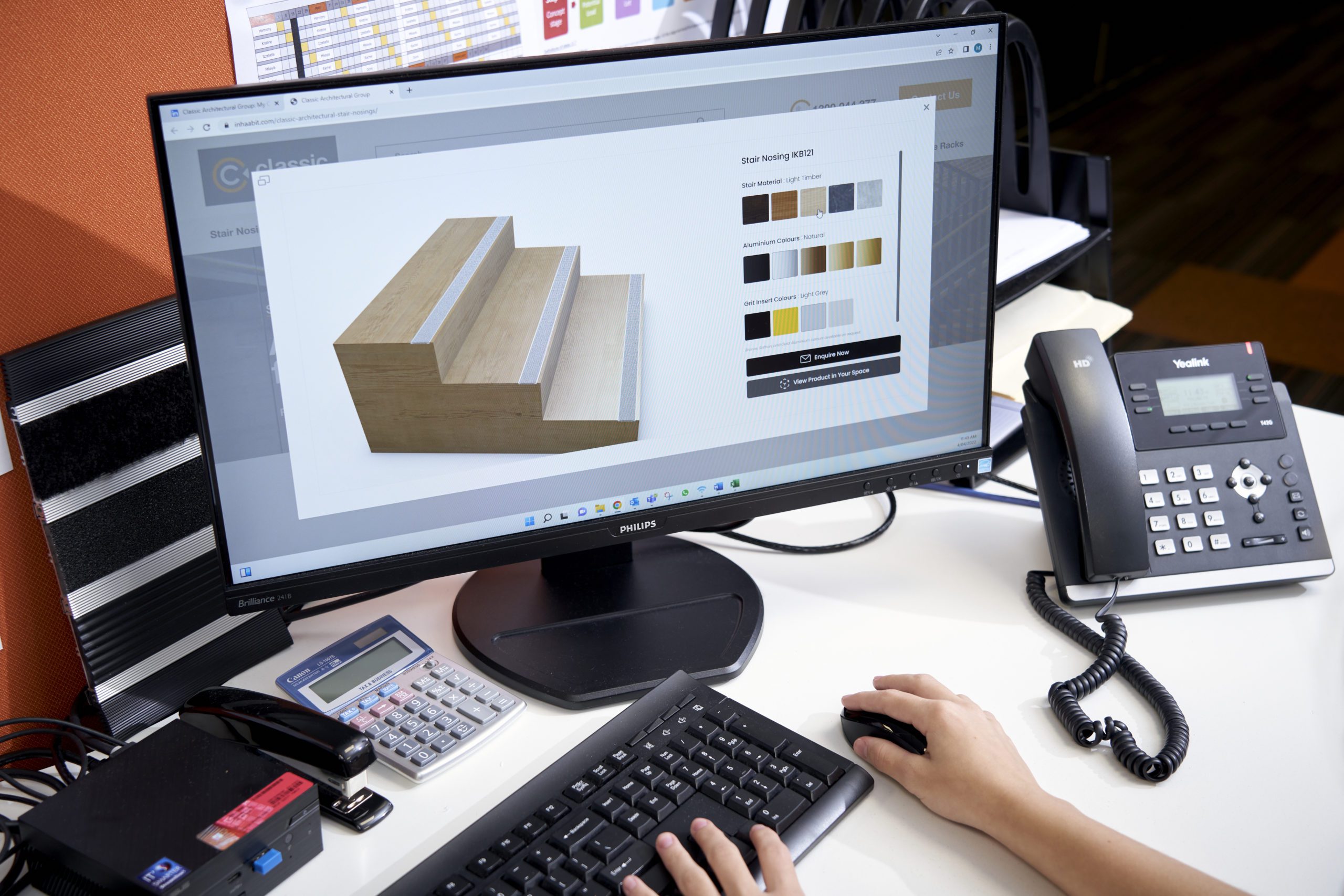Playing a vital role in creating safe, accessible spaces, stair nosings provide essential visual and tactile cues that help prevent accidents and improve stairway usability, particularly for those with visibility or mobility impairments.
In outdoor environments, installing compliant stair nosings becomes even more critical, as dynamic environmental and high-traffic conditions can significantly impact safety and accessibility. Unlike indoor stairways, outdoor staircases are subject to varying light, weather, and surface conditions, increasing the risk of slips, trips, and falls while also impacting the durability of installed products.
In today’s article, we’ll explore the importance of selecting the right stair nosing for outdoor environments, including relevant compliance standards and key factors for optimal safety and performance.
Understanding the Importance of Stair Nosing for Outdoor Environments
Installing the right stair nosings is essential to minimise preventable injuries and avoid costly legal consequences if compliance standards are unmet.
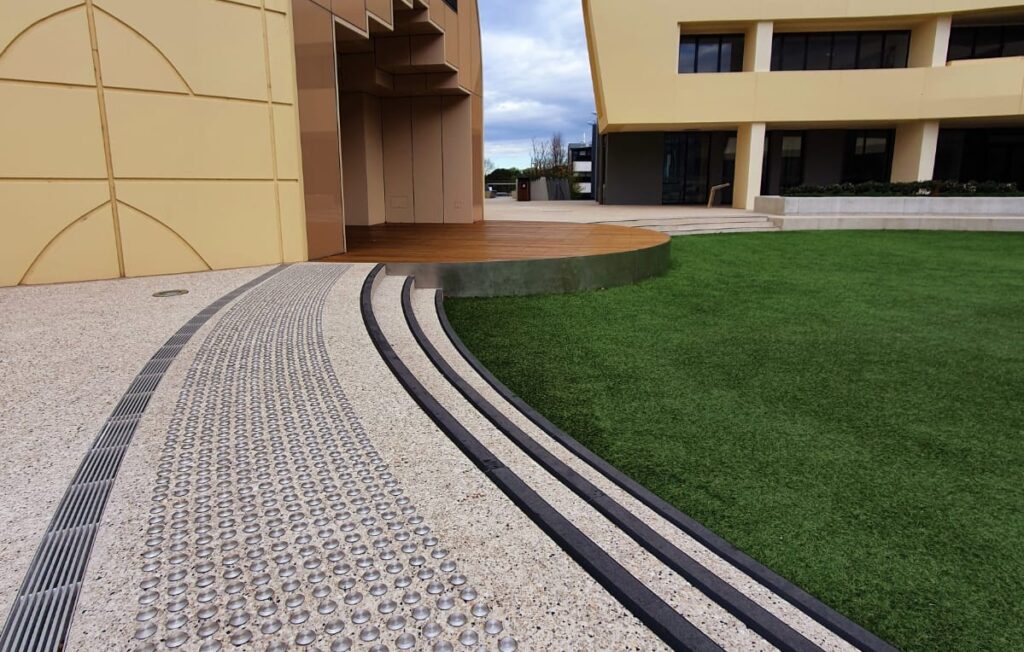
According to the Australian Institute of Health and Welfare, there were 15,458 hospitalisations resulting from falls on stairs or steps between 2021-22 and 98 fatalities between 2020-21. These figures highlight the critical role stair nosings play in enhancing the safety, accessibility, and usability of staircases.
Outdoor stair nosings must endure extreme weather conditions, including prolonged sun exposure, rain, and frost. High durability and UV-resistant materials are essential to prevent fading, cracking, or slipperiness over time, ensuring that outdoor stairways remain safe and functional in all conditions while maximising your long-term investment.
Compliance Standards for Accessible Stair Nosing in Australia
In Australia, the National Construction Code (NCC) and Building Code of Australia (BCA) incorporate Australian Standards that detail specific requirements for designing accessible environments, including provisions for mobility and access.
The BCA adopts AS1428.1:2021 as a legal requirement, focusing on accessible design standards to accommodate individuals with disabilities. This standard provides guidelines for constructing accessible stairways (excluding fire stairways) in all new developments and major refurbishments, ensuring safety and accessibility for people with disabilities.
Relevant to outdoor environments, AS4586:2013 outlines slip resistance classifications for materials, including stair nosing, to enhance safety in wet or slippery conditions. This helps maintain secure footing and is especially crucial in outdoor, high-traffic areas.
Additionally, The Disability Discrimination Act (DDA) mandates that buildings and facilities provide reasonable access for individuals with disabilities. This includes ensuring that stairways, walkways, and other communal spaces are safe, accessible, and supportive of all mobility needs.
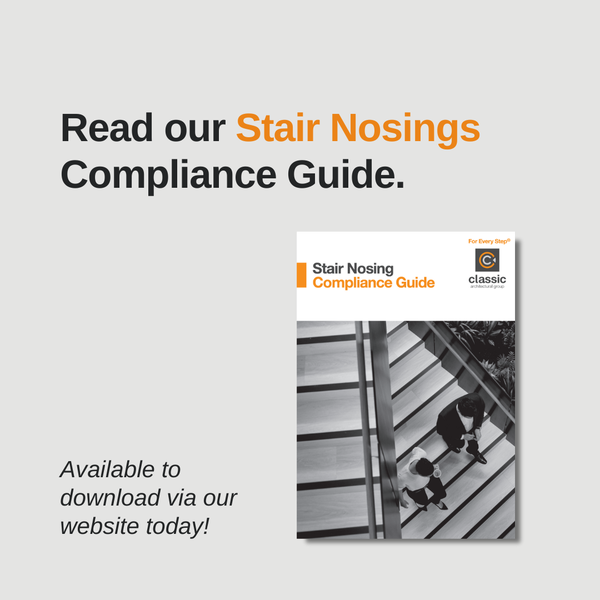
These standards apply to all various outdoor environments where public access is provided, including but not limited to commercial developments, residential apartments, and holiday rentals.
For more information on the applicable Australian Standards and other relevant guidelines, please download our updated Stair Nosing Compliance Guide.
5 Key Considerations to Assist with Outdoor Stair Nosing Selection
Aside from achieving your desired look, we strongly recommend selecting and specifying your stair nosing before designing and building your staircase, whether for indoor or outdoor use. This proactive approach ensures that you can account for any additional height added by the nosing during installation, per the AS1657:2018 requirements, which stipulate that risers must have a minimum height of 115mm and a maximum height of 190mm.
While our Stair Nosing Compliance Guide provides a detailed breakdown of the latest compliance criteria and best practice guidelines, below is an overview of the key factors to consider when selecting stair nosing for your outdoor project.
Slip Resistance
The top surface of stair nosings must feature a slip-resistant finish to mitigate the risk of slips and falls. The slip resistance rating should be at least P3, which indicates a moderate slip risk.

All stair nosing materials must undergo slip resistance testing to ensure proper classification following Australian Standard AS4586:2013. This is especially critical for outdoor areas, where environmental factors such as rain can create slippery surfaces.
Visibility
Stair nosings must span the path of travel of the stair tread and feature a single, continuous contrast strip.
The luminance contrast strip should be between 50mm and 75mm wide and cannot be set back from the tread/riser intersection by more than 15mm.
Luminance Contrast
AS1428.1:2021 specifies the Luminance Reflectance Value (LRV) requirements of stair nosings, ensuring maximum visibility for individuals with vision impairments.
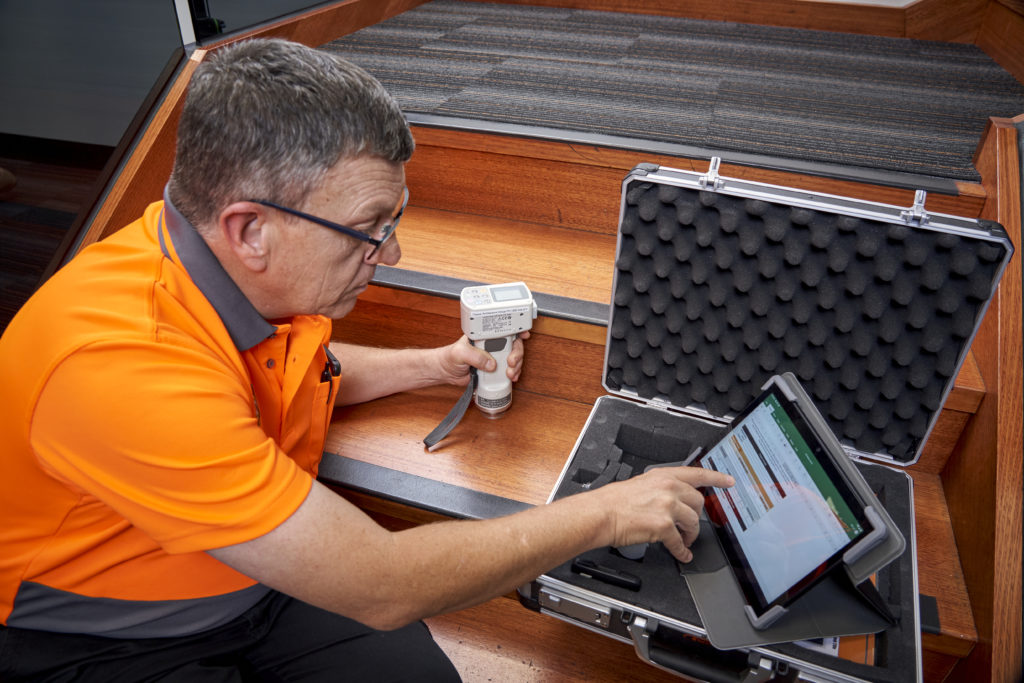
The contrast strip must provide at least 30% luminance contrast to the floor finish or background for optimal safety.
Material Durability
Stair nosings are typically made from highly durable, weather-resistant, and UV-stable materials such as aluminium and fibreglass for outdoor applications. Solid brass stair nosings are also gaining popularity due to their longevity and aesthetic appeal.
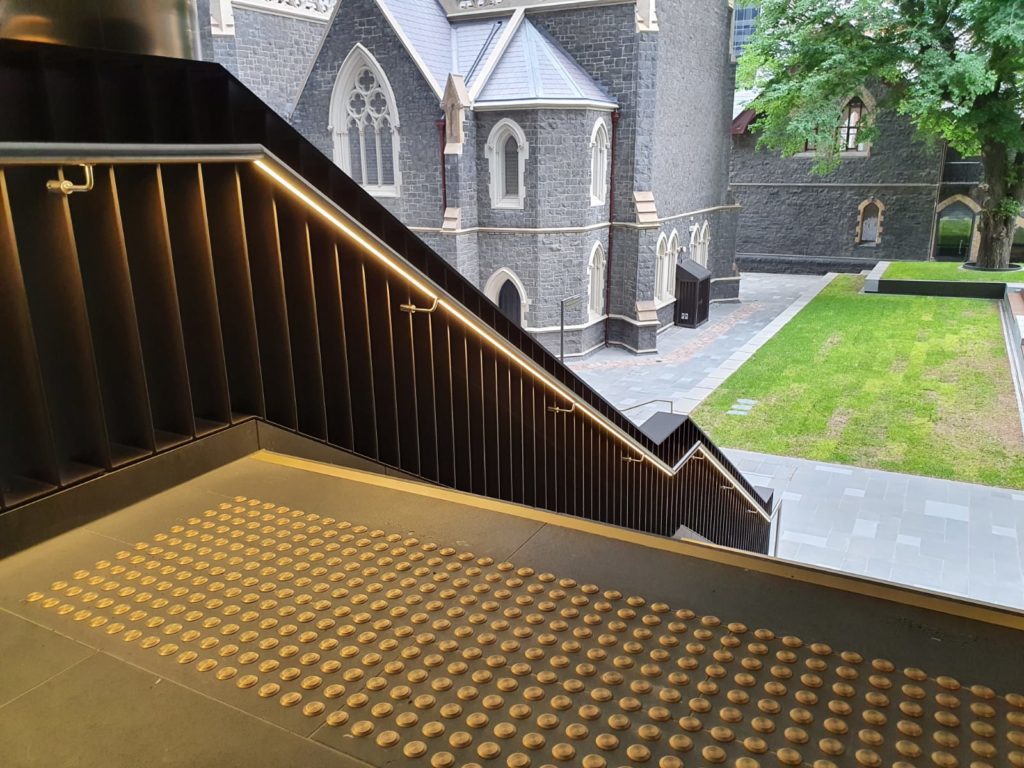
These materials are ideal for high-traffic areas and wet conditions, providing heavy-duty resistance to corrosion and wear.
Polymer inserts are commonly combined with metal nosings to enhance slip resistance, improve visibility, and reduce noise. Luminescent inserts are also popular for outdoor stair nosings, ensuring visibility at night and other low-light conditions.
Maintenance
Due to exposure to harsh weather conditions and other environmental factors, we recommend implementing a regular cleaning and maintenance schedule for outdoor stair nosings.
Periodic testing should also be conducted to ensure the continued performance of slip resistance, visibility, and overall durability. If any signs of wear, damage, or reduced functionality are detected, prompt replacement should be arranged to maintain safety standards.
Examples of recommended stair nosing installation for shared outdoor spaces
All outdoor areas with public access should follow relevant compliance guidelines for product selection, installation, and maintenance.
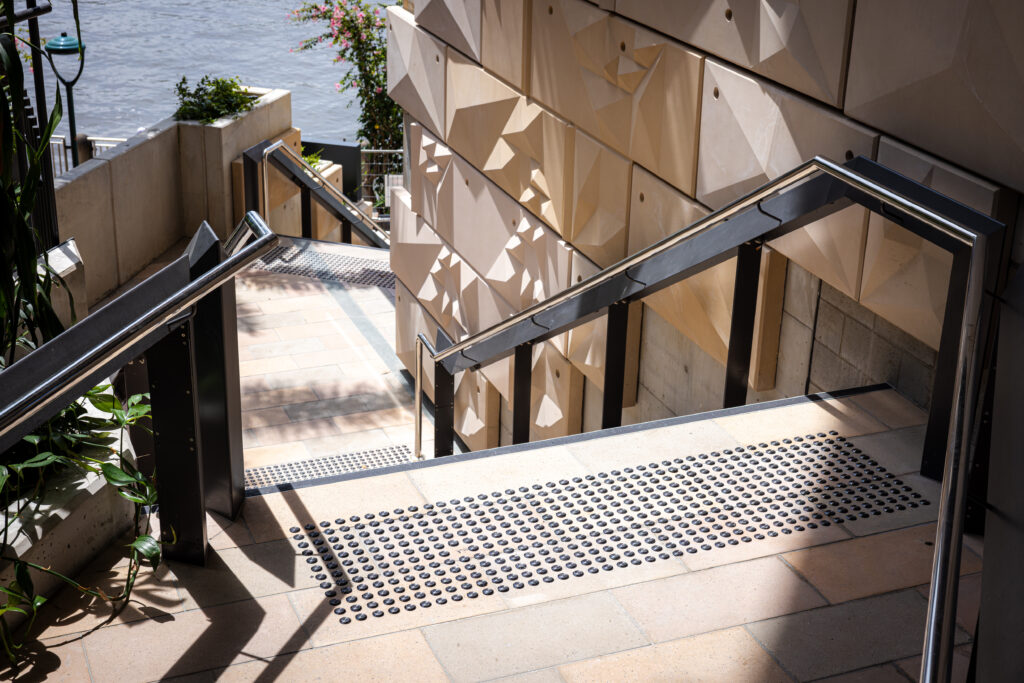
Here are some recommended guidelines for choosing and installing stair nosing for common outdoor areas:
- Public Parks: High-traffic areas in parks with varying light and weather conditions need durable, slip-resistant stair nosing, supported by regular inspections and maintenance. We recommend using stair nosing with a natural or matte finish to harmonise with outdoor aesthetics while providing ample visibility and contrast.
- Public Transport Stations & Facilities: In areas with heavy foot traffic, such as train stations, stair nosing should be made from robust, high slip-resistant materials. Luminescent or reflective finishes enhance visibility in low-light conditions and meet LRV compliance requirements, benefiting those with visibility impairments.
- Health & Community Facilities: Ensuring safe outdoor access for people with diverse visibility and mobility needs calls for stair nosings with high slip resistance and optimal colour contrast to maintain visibility at all times.
- Commercial Building Entrances: Sleek, weather-resistant stair nosing materials like solid brass, aluminium, or stainless steel with contrasting insert colours provide safe entry and exit while complementing the building’s architectural design.
- Educational Facilities: Schools and universities, which experience medium to high foot traffic throughout the day, benefit from stair nosings in highly durable, slip-resistant materials, such as Classic Tredfx Aluminium Stair Nosings, with bright finishes for added safety and visibility.
Other outdoor spaces, including hospitality and retail areas, sports and recreational facilities, and residential properties, can also benefit from selecting and installing the right stair nosing to enhance safety and accessibility.
Common Stair Nosing Mistakes to Avoid for Outdoor Spaces
- Failing to ensure that stair nosings meet the appropriate slip-resistance criteria
- Inadequate luminance contrast with the surrounding floor finish or background
- Choosing unsuitable materials for outdoor areas or selecting indoor-only stair nosings
- Not accounting for predicted pedestrian traffic volumes
- Underestimating and/or neglecting cleaning maintenance requirements
- Incorrect dimensions and improper installation according to relevant safety standards and manufacturer guidelines
- Overlooking aesthetics in relation to the space’s overall design and architecture
Stair nosings are problem solvers and problem preventers. The easiest way to avoid common stair nosing mistakes is by partnering with a provider who is up to speed on the latest compliance, testing, and installation guidelines.
Recent Classic Projects Featuring Outdoor Stair Nosing
Joel Selwood Stand, GMHBA Stadium (Kardinia Park), Victoria
Sports & Recreation project

Classic partnered with Besix Watpac on this world-class project, installing Classic Tredfx Safety Stair Nosings and Tactile Indicators, as well as Security Bollards and other Car Park Safety products throughout the vicinity.
Local Kensington, Victoria
Residential project

In collaboration with Hacer Group and Hayball Architecture, we supplied Classic Tredfx Safety Stair Nosings in stainless steel throughout the project, which features an array of shared indoor and outdoor amenities.
Truganina Community Centre, Victoria
Community & Cultural project

Supporting their goal to create a space promoting inclusivity and a strong sense of belonging, Classic supplied and installed Classic Tredfx Fibreglass Stair Nosings and Tactile Indicators throughout this project, ensuring high-traffic areas are safe and accessible.
Project: Truganina Community Centre
Better Access, Safety, and Compliance Begins with Classic
In addition to our comprehensive Stair Nosing Product Application Guide, our stair nosing range is AS1428 and NCC compliant with a lifetime warranty and 100% customer satisfaction guarantee. We also provide fire testing reports, LRV testing, and installation services for your peace of mind.

With over 40 years of experience enhancing public access and proudly partnering with leading building professionals Australia-wide, Classic Architectural Group specialises in end-to-end stair and floor safety products. From consultation and design to supply and installation, we deliver compliant solutions with fast turnarounds to ensure your success.
For expert advice on selecting and installing the best stair nosing for your project’s specific requirements, give us a call on 1300 244 377 or send us an online enquiry today.
